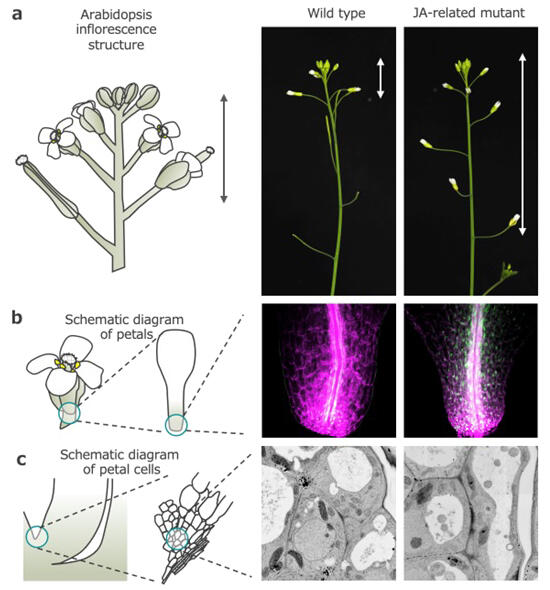A research group led by Associate Professor Nobutoshi Yamaguchi, Professor Toshiro Ito, Assistant Professor Makoto Shirakawa, and Assistant Professor Tatsuaki Goh of the Graduate School of Science and Technology at Nara Institute of Science and Technology (NAIST), Professor Takamasa Suzuki of the College of Bioscience and Biotechnology at Chubu University, Associate Professor Sumie Ishiguro of the Graduate School of Bioagricultural Sciences at Nagoya University, Team Leader Yasunori Ichihashi of the RIKEN BioResource Research Center, and Senior Technical Scientist Dr. Kiminori Toyooka of the RIKEN Center for Sustainable Resource Science has clarified the mechanism of petal abscission (i.e., detachment from the plant) at the molecular level. The study results were published in Nature Communications.

b. Arabidopsis petal bases. JA reporter expression in wild type and JA-related mutant is shown.
c. Arabidopsis petal cells. TEM images in wild type and JA-related mutant are shown.
Provided by NAIST
The joint research group conducted experiments on Arabidopsis thaliana flowers and found that jasmonic acid (a plant hormone that promotes aging) accumulates at the base of petals as they age. When jasmonic acid accumulates at the petal base, genes that control autophagy begin to function in a limited way at this part of the flower.
A round sac called an autophagosome forms to encapsulate substances in the cells at the petal base and becomes the carrier of autophagy, breaking down unwanted substances. This action changes the nature of the cells at the petal base, causing the old petals to detach from the plant selectively. The identification of the universal mechanism of petal detachment is expected to lead to applications in agriculture and horticulture.
Journal Information
Publication: Nature Communications
Title: Petal abscission is promoted by jasmonic acid-induced autophagy at Arabidopsis petal bases
DOI: 10.1038/s41467-024-45371-3
This article has been translated by JST with permission from The Science News Ltd. (https://sci-news.co.jp/). Unauthorized reproduction of the article and photographs is prohibited.




